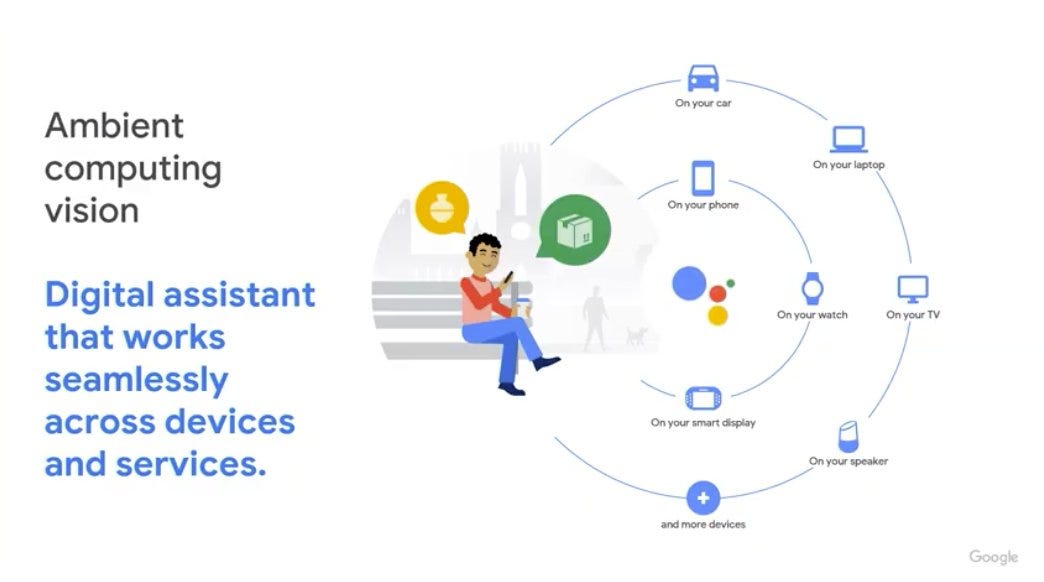
Web3. Metaverse. Crypto. Elon Musk. You’ve probably heard all of these tech buzzwords already. Let’s add a new one to our repertoire: Ambient Computing.
Ambient computing refers to “always-on” hardware and software technologies that allow users to consume digital content and services by interacting with their surroundings. We’re still at the beginning of the curve here but I predict over the next decade, there will be a fundamental shift in how we consume the internet. We will move away from our dependency on the smartphone, towards a device-agnostic consumption model.
To understand why ambient computing is coming, we need to look at how we got here first.
Desktop OS — Mac vs Windows (80s-90s)
Take yourself back to the time when Bill Gates wasn’t a billionaire and Steve Wozniak was the brains behind Apple Computers. In the late eighties and through the early nineties, there was a fierce battle to take the crown for the desktop operating system between Windows and Macintosh. Personal computing and desktops gained traction in the home and the enterprise and unequivocally, people made their choice: Windows.
However, there was one big physical limitation — the desktop was not portable. The user was constrained to working in whichever room the desktop was setup in. Until, of course, laptops happened and made the internet mobile.
Web OS — Chrome, Internet Explorer, Safari and Firefox (2000s)

In the 2000’s, when Facebook’s founders were writing their ranking algorithm on their dorm room windows and Zuckerberg was busy blowing off the Winklevi twins, something else was brewing. Internet adoption was growing rapidly. Computers became cheaper, and investment in the internet infrastructure grew exponentially. As more of the world’s population started to become netizens, the fight to become the browser of choice and operating system of the web heated up. Yet again, there was a clear winner: Google Chrome.
Mobile OS — iOS vs Android (2010s)

Then came the mobile revolution in 2007 when Steve Jobs was randomly firing employees he had just met in the elevator. The introduction of the iPhone quite literally put computing in our pockets. Mobile hardware devices got cheaper and more accessible, connecting almost 55% of the global population to the internet¹. Ever since then, Android and iOS have been duking it out to become the mobile OS of choice and they’ve both seem tremendous success (RIP Symbian OS). Notice a pattern with the desktop, web and mobile OS revolutions yet?
Each successive OS has made computing and the internet more omnipresent and mobile.
Platform OS — Siri, Alexa and Google Assistant (2020 — ?)
I think the next “OS” battle will for ambient computing. Alexa, Siri and Google Assistant have slowly crept into our lives and we’re becoming more comfortable with having them around us (let’s put the privacy concerns aside for a moment). I believe our reliance on one device will become obsolete. Instead, we will have an ecosystem of hardware and software products that will create an ambient computing bubble around us everywhere we go. There won’t be a need to pull out our smartphone every time we need something. We will be able to access technology regardless of where we are and what device we use, just ask and it will be done. Need milk, diapers and some wine? No problem, just ask your fridge and it’ll place an Instacart order for you. Having a stressful day and need 10 minutes to meditate and reset? Setup a rule in Apple Health to automatically dim the lights and turn on a guided meditation from Headspace when your heart rate or blood pressure exceeds a threshold. You get the idea…
However, the real power of ambient computing comes from having all of your information, rules and preferences with one provider. My hypothesis is that big tech is investing heavily in their hardware suite of products to further create ecosystem lock-in with their users. Why do you think Google bought Nest and Fitbit and has a whole range of products for in-home and outside the home? Why is Amazon investing in an extensive suite of hardware devices? Why did Apple build the HomePod? Why is Microsoft building the HoloLens? They all want to take the biggest share of each user’s ambient computing bubble.
Okay….what’s your point?
If you’re a product manager or UX designer, start thinking about the problems that can be solved through ambient computing. Become cognizant of the shift in how users are going to be consuming the internet and digital services in the next decade. I think there will be less pixel-pushing and a larger focus on interface design and research. How do we apply human-centered design principles to voice-based or gesture-first products? I don’t have the answers but I’m excited to find out.